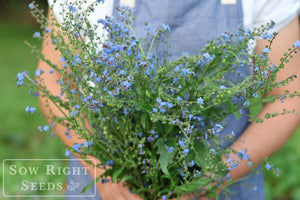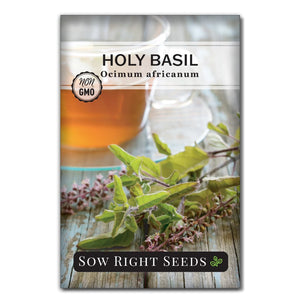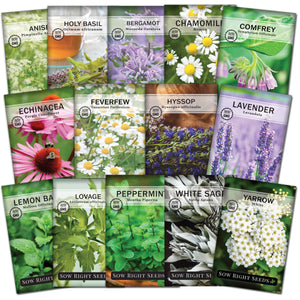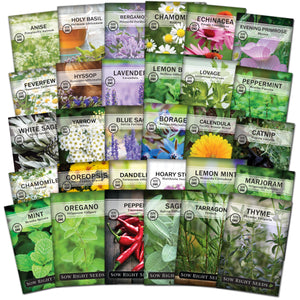Tulsi, the Incomparable One: How to Grow and Care for Holy Basil Plants
Medicinal herbsHoly basil, also known as "tulsi", has been cherished for centuries in Ayurvedic medicine for its healing properties. This versatile herb is a joy to grow in your own garden. Whether you're interested in its health benefits or as a fragrant addition to your herb garden, growing holy basil from seed is rewarding and simple. In this guide, we'll walk you through everything from planting to harvesting.

Quick Links
What is Holy Basil?
We grow many varieties of basil, and each one has its own distinct flavor and use. Holy basil is a native plant in India and has been used in Ayurvedic medicine for over 3000 years. Known as Tulsi in Hindi, which means “The Incomparable One,” holy basil is also called “The Queen of Herbs” and “Mother Medicine of Nature.” It is considered sacred in Hinduism and is typically grown in pots in Hindu households.

Holy Basil has a mild spice scent and is widely planted in India around temples and in gardens. All parts of the revered plant are used for practical and ceremonial purposes.

How to Grow Holy Basil from Seed
Holy basil is an annual that enjoys warmth and sunshine, so starting seeds indoors will ensure a successful growing experience. To start growing holy basil seeds indoors:
-
Sprinkle the seeds over a fine-textured growing medium in pots or trays and cover them with 1/4” of soil. Lightly mist the surface and keep the soil moist but not soggy. You can cover the trays or pots with a dome or plastic wrap to hold the moisture in.
-
Keep the seeds warm and protected. Use heating mats if needed to keep the temperature at least 60ºF.
-
Tulsi basil seeds need light to germinate, so place them under grow lights or bright, indirect sunlight. Germination typically takes 6 to 12 days.
- Once they have started sprouting, keep the seedlings moist. You may need to continue using a dome. Once the plants have grown enough to have true leaves and are several inches high, they can be hardened off to transplant outside. Do not plant them directly into the garden until the soil has warmed and outdoor temperatures don’t dip below 50ºF.
This heirloom variety of Holy Basil (Ocimum africanum) is also known as Sacred Basil or Tulsi. Holy basil can be brewed into tea or used in a variety of dishes. The flavor is a mix of clove, mint, and peppers. Add it to your indoor or outdoor herb garden.

Caring for Holy Basil Plants
When you're ready to plant holy basil in your garden, choose a sunny location where the plants can get 4-6 hours of sunlight a day. Holy basil can handle some shade but prefers warmth. To prevent fungal disease, give the plants enough room for good airflow.
Once the holy basil plants are in the garden, maintain regular watering to keep the roots moist but not soggy. Good drainage is essential. Water when the top inch is dry, and use soaker hoses or drip irrigation to keep the leaves dry.
It is also a good idea to use organic mulch to keep down weeds and preserve soil moisture. This organic material will enrich the soil and achieve a better flavor than fertilizers.
The tiny seedlings can take time to grow, but holy basil will grow rapidly once outdoors, with temperatures more than 60ºF.
During the growing season, regularly pinch out flower heads to promote bushy plant growth and prolong the plant's productive life.

Growing Holy Basil Indoors
Holy basil can be easily grown indoors as well. Choose a pot large enough to handle the plants, as they can grow two feet high. Make sure the indoor location has 4-6 hours of sunlight.

Harvesting Holy Basil
Like other varieties of basil, holy basil can be harvested at any time during the growing season. You can pick individual leaves as needed or cut whole branches at a time.
It is best to gather basil in the morning after the dew has dried and the plant oils are at their highest level. Use sharp garden shears to cut right above the leaf nodes. This will allow the plant to keep growing as it sends out side branches.
After cutting, you can place stems in a glass of water to keep them fresh for several days.
To dry holy basil, you can either gather bundles and dry them upside down or place them in a dehydrator on the herb setting or 95 degrees.
You can prevent holy basil plants from bolting by regular harvesting and pinching off the top growth to keep it from going to seed. This will encourage the plant to continue growing leaves.
However, if you want to harvest the seeds, allow the plant to grow naturally. This will allow the plant to put its energy into growing flowers, which will develop into seeds. Allowing the plant to produce flowers has the added benefit of attracting honey bees.

What is Holy Basil Used For?
Revered for its medicinal and spiritual properties, holy basil has been used for centuries to heal and strengthen the body.
The most common way to consume holy basil is to drink it as tea, also known as Tulsi tea.
In traditional medicines, holy basil tea is consumed several times a day to help the body deal with physical and emotional stress.
Studies suggest that holy basil can help regulate cortisol levels and blood sugar. It has also been shown to help people feel more social and less anxious.
In addition to helping with anxiety, traditional uses for holy basil include treating earaches, coughs, colds, indigestion, ringworm, skin infections, dysentery, and malaria.
Sometimes called “hot basil” because of its peppery taste, holy basil has been used to decrease pain and swelling, lower blood sugar, and reduce stress and anxiety. Drinking daily cups of tulsi tea is believed to regulate cortisol levels and help your body better respond to stress.

Using Holy Basil
- When using fresh herbs, remember that fresh has more water than dried, so you need to use more fresh herbs to achieve the same strength.
- Holy basil can be used topically for skin infections and added to bath soaks.
- Adding it to Asian dishes and soups can increase the health benefits, but don’t expect it to taste like other varieties of basil with its spicy and peppery flavor.
- It can be made into an essential oil.
- The most common way to enjoy holy basil is in herbal Tulsi tea.

How to Make Holy Basil Tea
To make a warm tea, place 1-2 teaspoons of dry or 2-3 teaspoons of fresh leaves into a cup. Pour 1 cup of boiling water over and let steep for 5-10 minutes. Drain leaves and enjoy.
For a cool drink, place flowering tops, stems, and leaves in a clear glass quart jar. Fill the jar with boiling water and let it sit for several hours. Then place in the fridge. Serve it cold.
Cautions: As with all medicinal herbs, use caution when consuming more than a small amount of holy basil. Holy basil may slow blood clotting and is not recommended for people who are taking blood thinners. Consult your doctor if you are trying to conceive or are pregnant.
Holy basil is an excellent herb to add to your medicinal herb garden. Growing your own herbs will ensure that you have a healthy supply of fresh, pesticide-free herbs you need for home remedies.

Growing holy basil at home can bring a sense of connection to ancient traditions. You’ll also have the satisfaction of harvesting a sacred herb with incredible wellness benefits. Whether you're drawn to its spiritual significance or the soothing flavor of freshly brewed tulsi tea, cultivating holy basil is an experience every gardener can enjoy.
Now that you know how to grow it, you can add holy basil to your garden and start enjoying its many health benefits. Start growing holy basil today by planting seeds from Sow Right Seeds. With just a little care, you’ll soon have a vibrant herb garden filled with this cherished plant.










Leave a comment